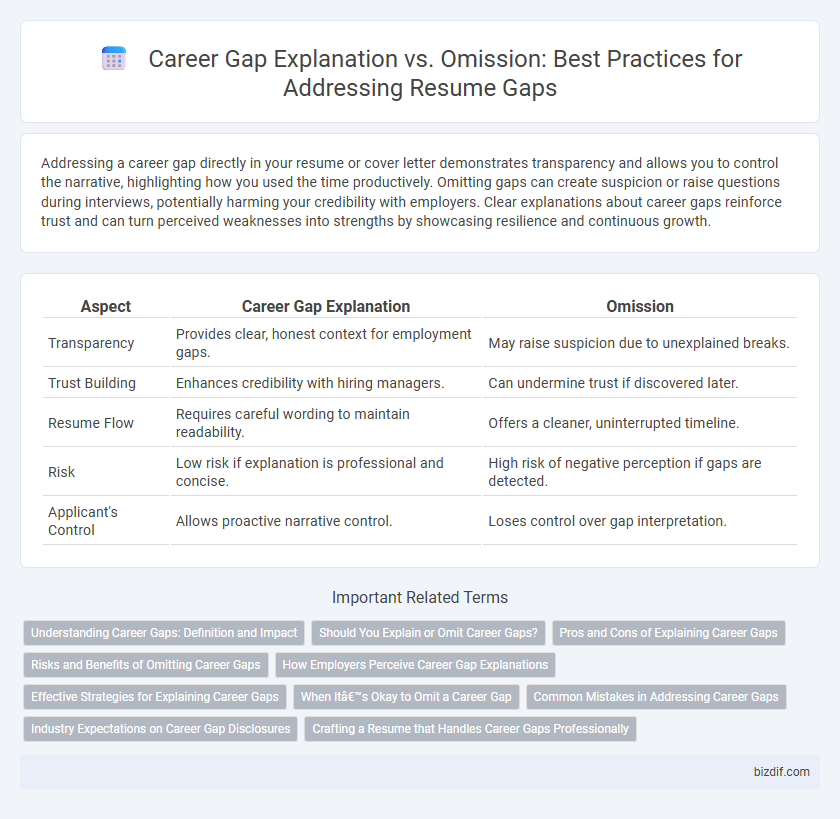Addressing a career gap directly in your resume or cover letter demonstrates transparency and allows you to control the narrative, highlighting how you used the time productively. Omitting gaps can create suspicion or raise questions during interviews, potentially harming your credibility with employers. Clear explanations about career gaps reinforce trust and can turn perceived weaknesses into strengths by showcasing resilience and continuous growth.
Table of Comparison
| Aspect | Career Gap Explanation | Omission |
|---|---|---|
| Transparency | Provides clear, honest context for employment gaps. | May raise suspicion due to unexplained breaks. |
| Trust Building | Enhances credibility with hiring managers. | Can undermine trust if discovered later. |
| Resume Flow | Requires careful wording to maintain readability. | Offers a cleaner, uninterrupted timeline. |
| Risk | Low risk if explanation is professional and concise. | High risk of negative perception if gaps are detected. |
| Applicant's Control | Allows proactive narrative control. | Loses control over gap interpretation. |
Understanding Career Gaps: Definition and Impact
Career gaps refer to periods when a professional is not actively employed, often due to reasons like personal development, health issues, or caregiving. Properly addressing career gaps in a resume can demonstrate transparency and resilience, which improves an employer's confidence. Omitting career gaps may raise concerns about honesty and lead to missed job opportunities.
Should You Explain or Omit Career Gaps?
Explaining career gaps in a resume provides transparency and can highlight valuable experiences gained during the break, such as freelancing, education, or caregiving. Omitting career gaps may raise suspicion during background checks or interviews, potentially hurting credibility with recruiters. Tailoring the approach depends on the duration of the gap, relevancy to the job, and how effectively the candidate can demonstrate ongoing professional development.
Pros and Cons of Explaining Career Gaps
Explaining career gaps in a resume can demonstrate transparency and provide context that reassures employers about your reliability and continuous growth, especially if the gap involved skill development or personal challenges. However, detailed explanations risk drawing attention to potential red flags or perceived lack of professionalism, which some recruiters might view negatively. Omitting career gaps might keep resumes concise and focused on achievements but can create suspicion or lead to uncomfortable questions during interviews, potentially weakening trust.
Risks and Benefits of Omitting Career Gaps
Omitting career gaps on a resume can reduce immediate red flags for employers but carries the risk of appearing dishonest if discovered, potentially harming trust and job prospects. Transparent explanations of career gaps allow candidates to control the narrative and highlight productive activities like skill development or volunteering, enhancing credibility. Employers increasingly value honesty and context, making strategic disclosure of gaps a safer approach than omission.
How Employers Perceive Career Gap Explanations
Employers often view transparent career gap explanations as a sign of honesty and professionalism, increasing trustworthiness in candidates. Clear communication about gaps, including reasons like skill development or personal circumstances, can mitigate concerns about employability or commitment. Omitting career gaps may raise red flags, prompting employers to question a candidate's reliability and potentially leading to disqualification.
Effective Strategies for Explaining Career Gaps
Addressing career gaps with transparency and concise explanations enhances trust and credibility in resumes, preventing employers from assuming negative reasons for employment interruptions. Effective strategies include briefly stating the reason for the gap, such as further education, caregiving, or skill development, while emphasizing any relevant activities or achievements during that time. Tailoring explanations to align with job requirements helps maintain a positive narrative and highlights continuous professional growth despite interruptions.
When It’s Okay to Omit a Career Gap
Omitting a career gap on a resume is acceptable when the gap is brief, unrelated to the desired job, or when the applicant has relevant experience that overshadows the gap. Candidates returning from short-term personal reasons, such as travel or family care, may choose omission if the gap does not impact their qualifications. Transparency becomes essential for longer or employment-related gaps, but small gaps of a few months can be strategically left out to keep the resume concise and focused on skills.
Common Mistakes in Addressing Career Gaps
Common mistakes in addressing career gaps on a resume include omitting the gap entirely, which can raise red flags for employers, and providing vague or inconsistent explanations that lack clarity. Job seekers often fail to highlight relevant skills or experiences gained during the gap, missing opportunities to demonstrate growth and learning. Clear, honest, and concise explanations paired with positive framing help maintain trust and keep the focus on qualifications.
Industry Expectations on Career Gap Disclosures
Employers increasingly expect transparent career gap explanations to assess candidate reliability and skill retention, viewing omissions as potential red flags that may harm trustworthiness. Industry norms emphasize honest disclosure supported by constructive explanations like skill development, education, or personal growth to mitigate negative perceptions. Tailoring gap narratives to align with role requirements enhances credibility and meets sector-specific standards for candidacy evaluation.
Crafting a Resume that Handles Career Gaps Professionally
Crafting a resume that addresses career gaps professionally involves transparent yet strategic explanation, emphasizing skills and experiences gained during the hiatus. Omitting gaps risks raising questions, while thoughtfully explaining them with concise, positive framing maintains credibility and showcases continuous growth. Including relevant volunteer work, freelance projects, or certifications during the gap strengthens the resume by highlighting ongoing professional development.
Career Gap Explanation vs Omission Infographic

 bizdif.com
bizdif.com